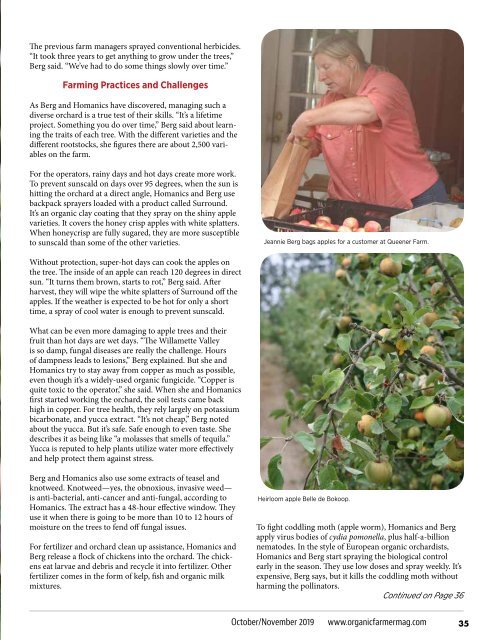Organic Farmer October/November 2019
You also want an ePaper? Increase the reach of your titles
YUMPU automatically turns print PDFs into web optimized ePapers that Google loves.
The previous farm managers sprayed conventional herbicides.<br />
“It took three years to get anything to grow under the trees,”<br />
Berg said. “We’ve had to do some things slowly over time.”<br />
Farming Practices and Challenges<br />
As Berg and Homanics have discovered, managing such a<br />
diverse orchard is a true test of their skills. “It’s a lifetime<br />
project. Something you do over time,” Berg said about learning<br />
the traits of each tree. With the different varieties and the<br />
different rootstocks, she figures there are about 2,500 variables<br />
on the farm.<br />
For the operators, rainy days and hot days create more work.<br />
To prevent sunscald on days over 95 degrees, when the sun is<br />
hitting the orchard at a direct angle, Homanics and Berg use<br />
backpack sprayers loaded with a product called Surround.<br />
It’s an organic clay coating that they spray on the shiny apple<br />
varieties. It covers the honey crisp apples with white splatters.<br />
When honeycrisp are fully sugared, they are more susceptible<br />
to sunscald than some of the other varieties.<br />
Jeannie Berg bags apples for a customer at Queener Farm.<br />
Without protection, super-hot days can cook the apples on<br />
the tree. The inside of an apple can reach 120 degrees in direct<br />
sun. “It turns them brown, starts to rot,” Berg said. After<br />
harvest, they will wipe the white splatters of Surround off the<br />
apples. If the weather is expected to be hot for only a short<br />
time, a spray of cool water is enough to prevent sunscald.<br />
What can be even more damaging to apple trees and their<br />
fruit than hot days are wet days. “The Willamette Valley<br />
is so damp, fungal diseases are really the challenge. Hours<br />
of dampness leads to lesions,” Berg explained. But she and<br />
Homanics try to stay away from copper as much as possible,<br />
even though it’s a widely-used organic fungicide. “Copper is<br />
quite toxic to the operator,” she said. When she and Homanics<br />
first started working the orchard, the soil tests came back<br />
high in copper. For tree health, they rely largely on potassium<br />
bicarbonate, and yucca extract. “It’s not cheap,” Berg noted<br />
about the yucca. But it’s safe. Safe enough to even taste. She<br />
describes it as being like “a molasses that smells of tequila.”<br />
Yucca is reputed to help plants utilize water more effectively<br />
and help protect them against stress.<br />
Berg and Homanics also use some extracts of teasel and<br />
knotweed. Knotweed—yes, the obnoxious, invasive weed—<br />
is anti-bacterial, anti-cancer and anti-fungal, according to<br />
Homanics. The extract has a 48-hour effective window. They<br />
use it when there is going to be more than 10 to 12 hours of<br />
moisture on the trees to fend off fungal issues.<br />
For fertilizer and orchard clean up assistance, Homanics and<br />
Berg release a flock of chickens into the orchard. The chickens<br />
eat larvae and debris and recycle it into fertilizer. Other<br />
fertilizer comes in the form of kelp, fish and organic milk<br />
mixtures.<br />
Heirloom apple Belle de Bokoop.<br />
To fight coddling moth (apple worm), Homanics and Berg<br />
apply virus bodies of cydia pomonella, plus half-a-billion<br />
nematodes. In the style of European organic orchardists,<br />
Homanics and Berg start spraying the biological control<br />
early in the season. They use low doses and spray weekly. It’s<br />
expensive, Berg says, but it kills the coddling moth without<br />
harming the pollinators.<br />
Continued on Page 36<br />
<strong>October</strong>/<strong>November</strong> <strong>2019</strong><br />
www.organicfarmermag.com<br />
35


















